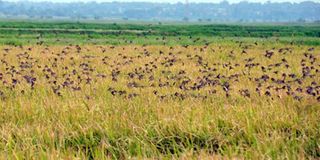Uproar over killing of rare bird

Quelea birds fly over a rice field recently at the Kibimba Rice Scheme in Bugiri District. PHOTO BY DAVID AWORI
What you need to know:
Ministry of Tourism officials say the decision to indiscriminately spray the quelea birds with poison has negative impacts on both the environment and tourism.
Kampala
When the Ministry of Agriculture, Animal Industry and Fisheries was on Monday faced with the challenge of quelea birds eating rice at Kibimba Rice Scheme, their immediate remedy was to kill them by spraying.
This has spurred fury among bird lovers and conservationists who say this was not only a breach of wildlife laws, but also endangering to other animal species not targeted by the spraying.
In an interview with the Daily Monitor, the acting public relations officer, ministry of Tourism, Wildlife and Antiquities, Mr Akankwasah Barirega, said the ministry is worried that other non-target species, especially pollinators like bees and butterflies, could have ended up dying which could pose a threat to future food production.
“While we agree with the need to control the birds from destroying crops and causing losses to farmers, the unilateral action taken to indiscriminately spray poison without due consultation and or conducting any environmental impact assessment is not only in breach of the National Environment Act Cap 153, but also has serious ramifications for environment, tourism and hence national economy,” Mr Barirega said.
1.8 million killed
The Ministry of Agriculture in partnership with the Desert Locust Control Organisation of East Africa on Monday carried out a pest control exercise at Kibimba Rice Sheme in Bugiri District, spraying dead about 1.8 million quelea birds that were destroying an estimated 15 tonnes of rice a day.
Section 15 of the Uganda Wildlife Act, Cap 200 requires an environmental impact assessment for any activity likely to have significant impact on any wildlife species or community, and section 96 of the National Environment Act criminalises conducting such activities like aerial spray or introducing new pesticides without conducting an environment impact assessment.
The Ministry of Agriculture did not, however, conduct an environmental Impact assessment before carrying out the aerial spray. Mr Stephen Byantwale, the Principal Agriculture Inspector in the Ministry of Agriculture, said the exercise was aimed at controlling more than 2 million quelea birds that had migrated into the county and were causing destruction.
Mr Acheles Byaruhanga, the executive director of Nature Uganda and a bird’s researcher, said the option of killing birds is an indication of poor planning on the side of the Ministry of Agriculture and that it does not solve the problem.
Mr Byaruhanga said the quelea birds are a native of Uganda which breed in swampy areas and do not move in huge numbers of millions as agriculture officials claim.
“First these birds’ habitats has been destroyed and they need to look for means of survival. Secondly these birds feed on cultivated crops during breeding seasons therefore the Ministry of Agriculture should advice farmers on when cultivation should be which should not be during the birds’ breeding season to minimise loses,” Mr Byaruhanga said, adding that the poisonous spray could easily find its way into the soil.
Bird haven
Uganda is globally known as the bird haven of Africa and birding is one of the biggest tourism products for the country. According to the Ministry of Tourism, Uganda generates more than $6 million annually from birding tourism alone.
Mr Barirega said other methods like mist trapping, scaring, aerial spray but after careful planning and following an environmental Impact assessment and spraying hot water without using poisonous chemicals could have been deployed.




